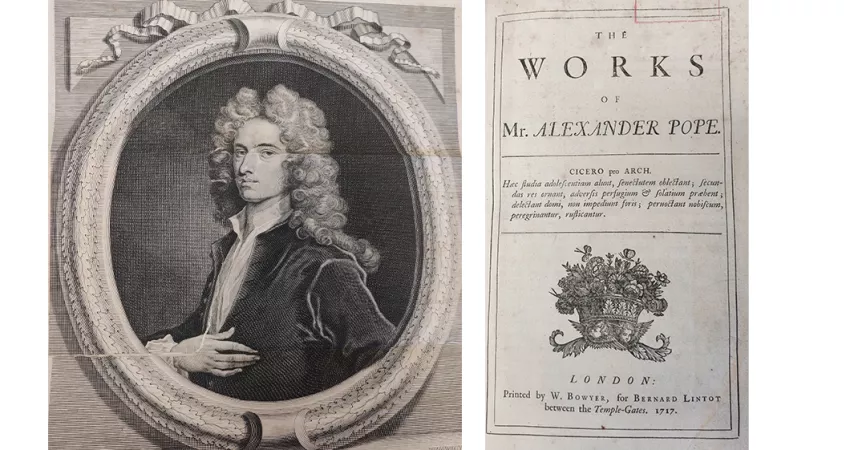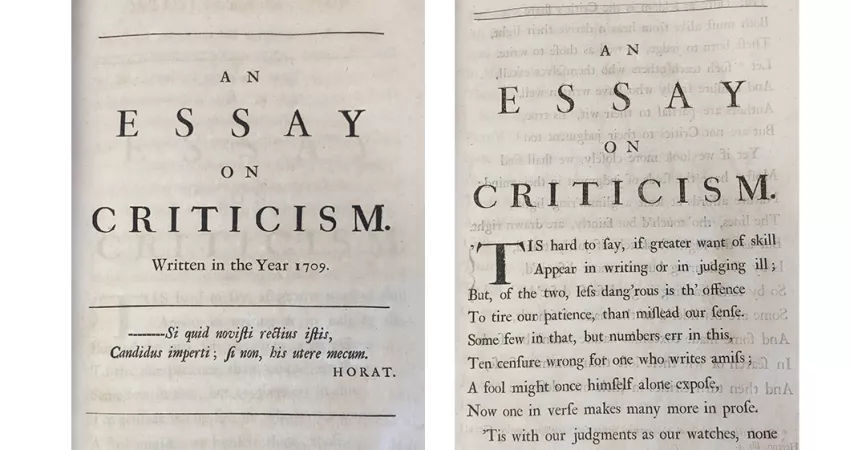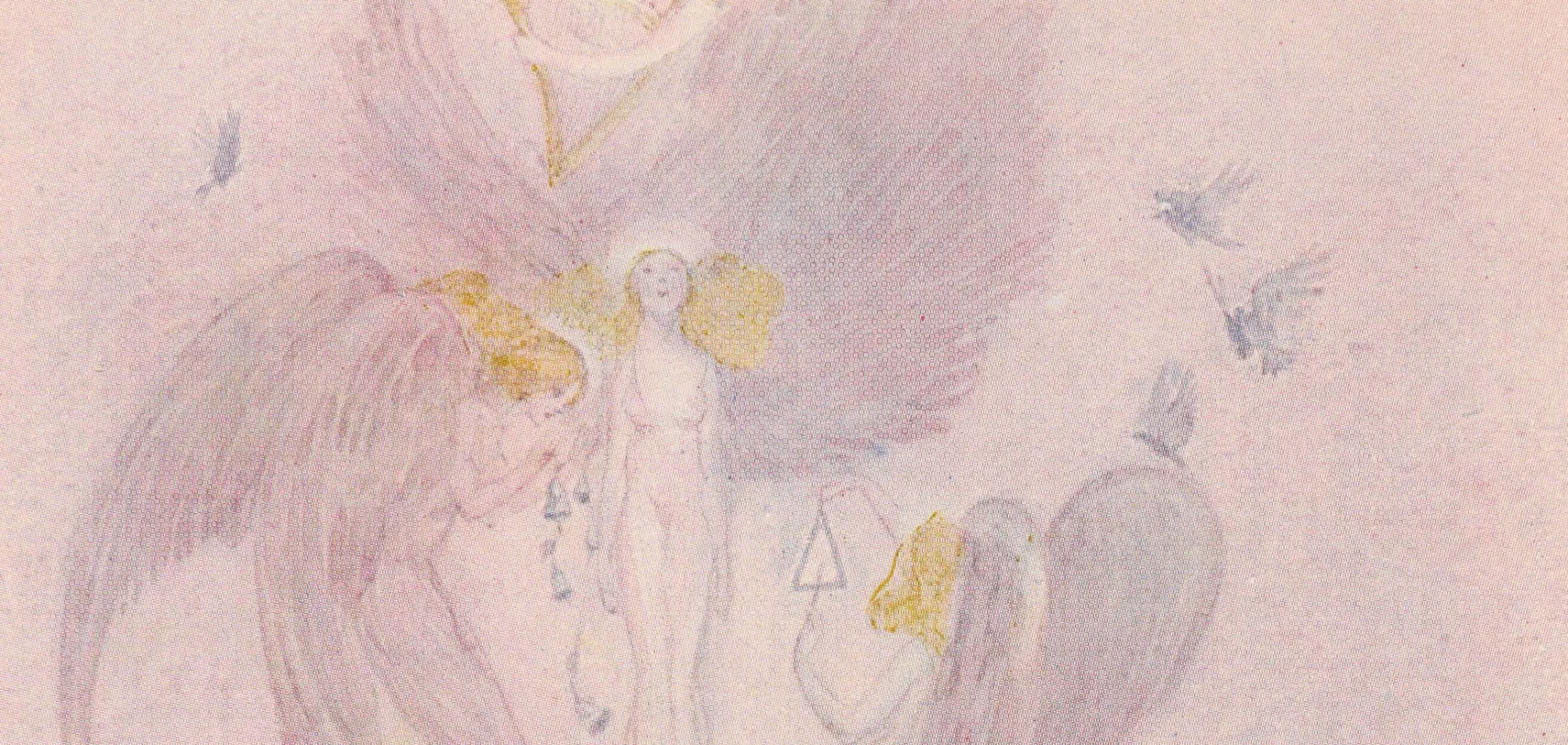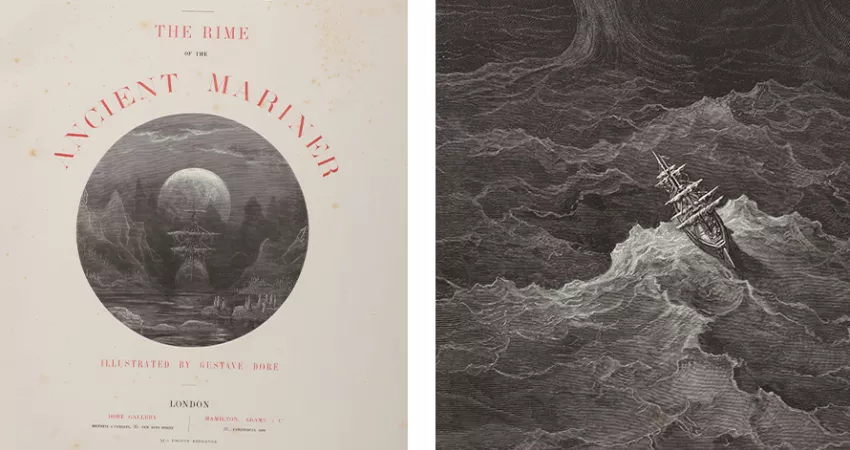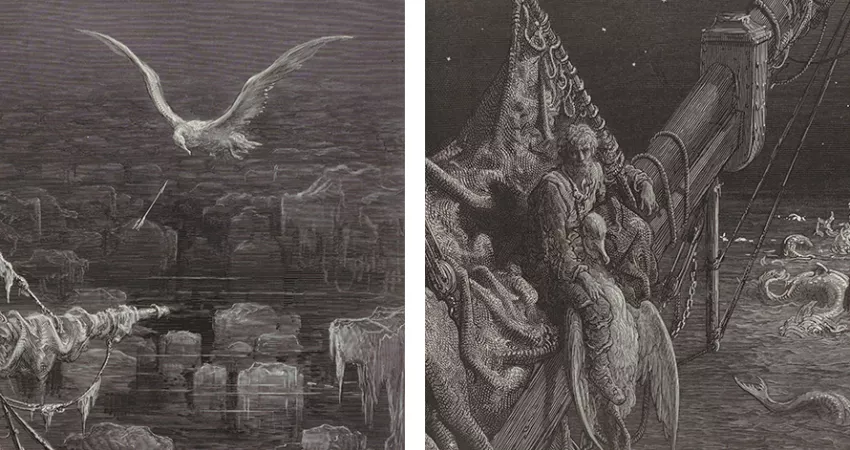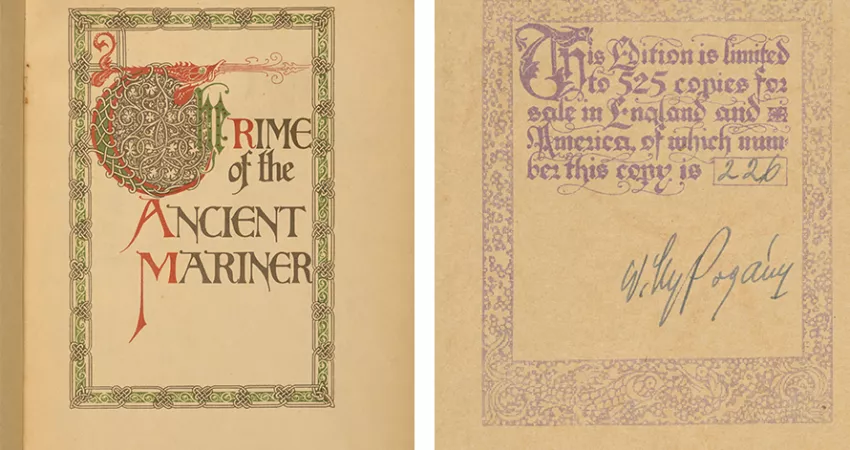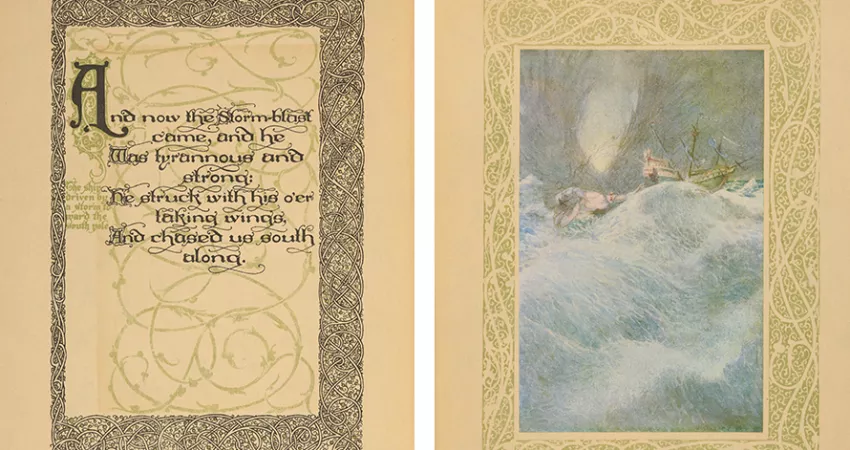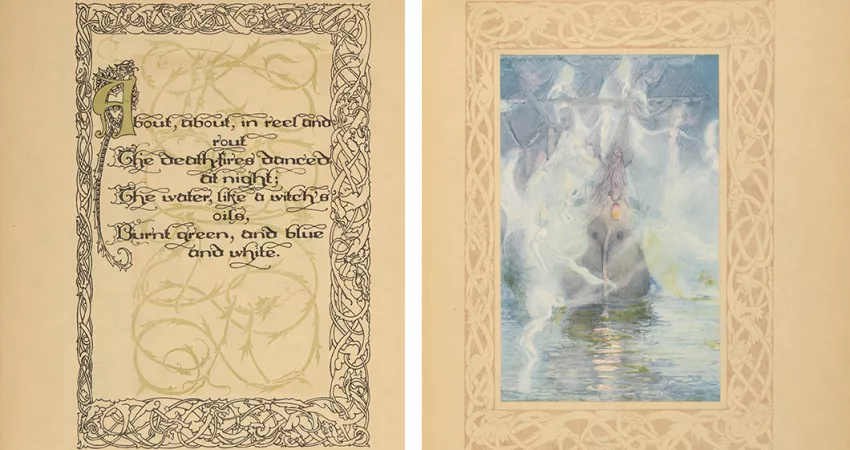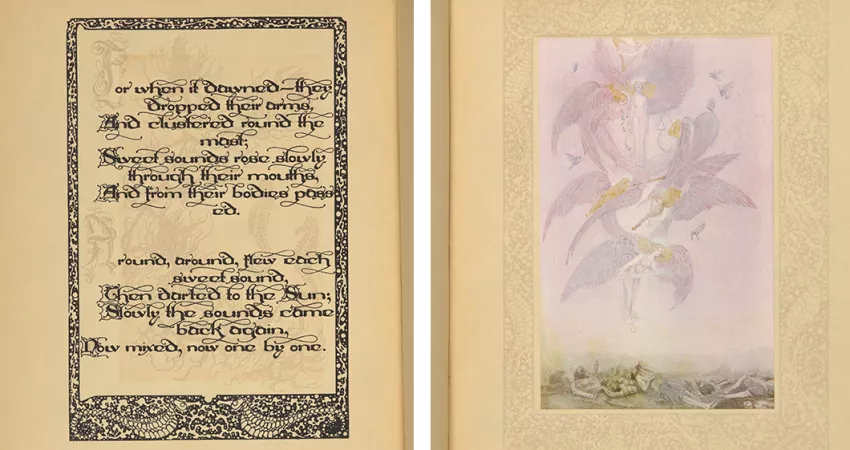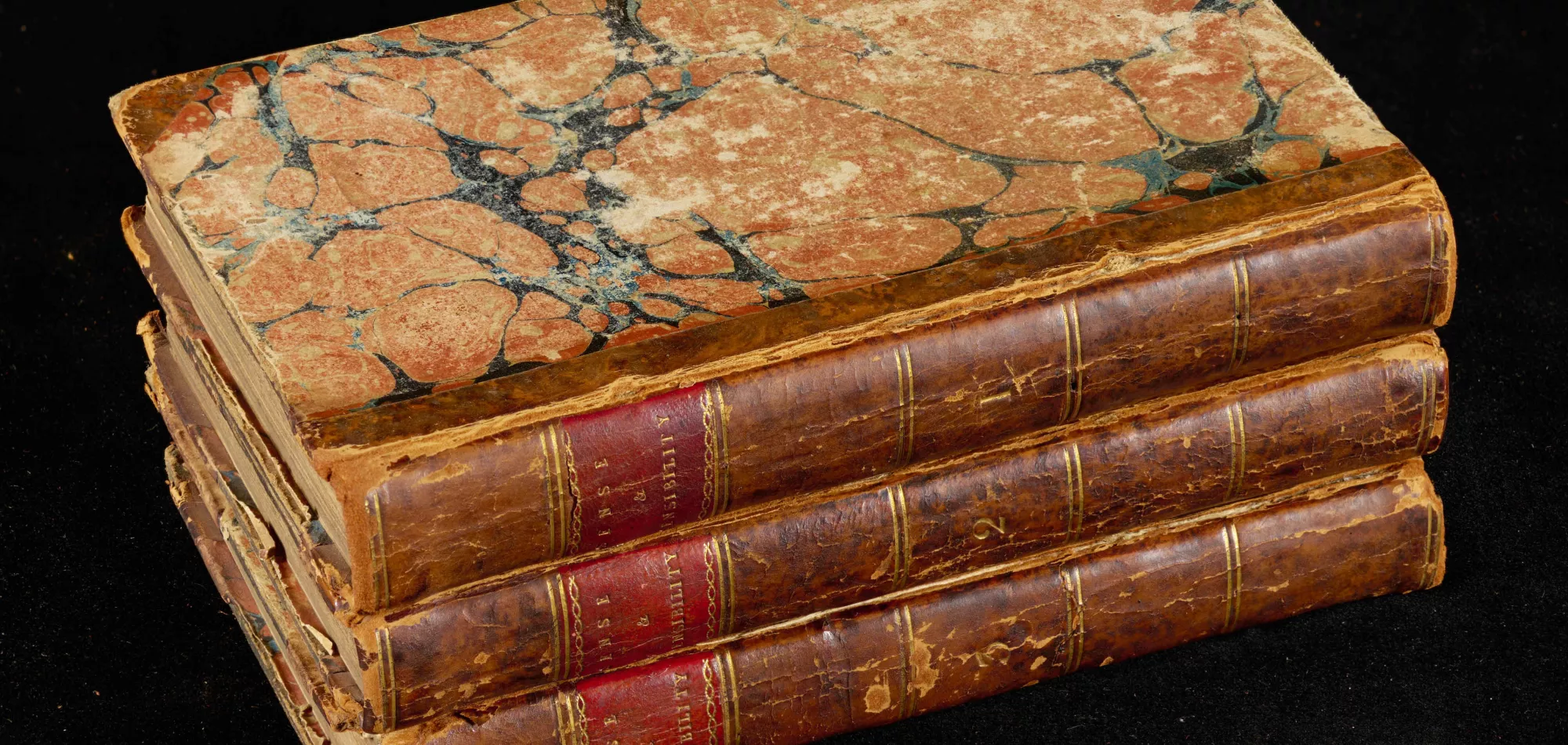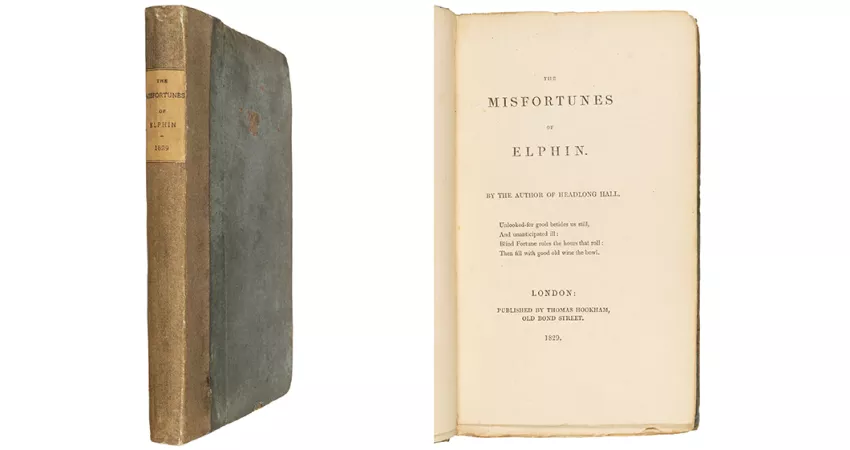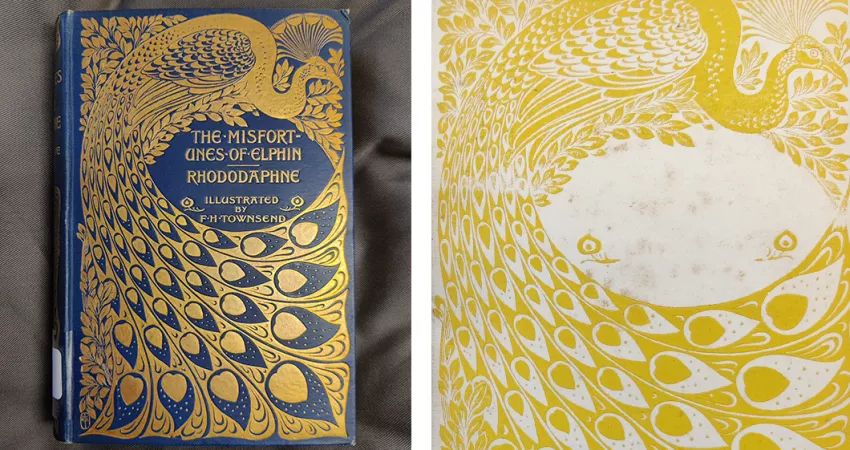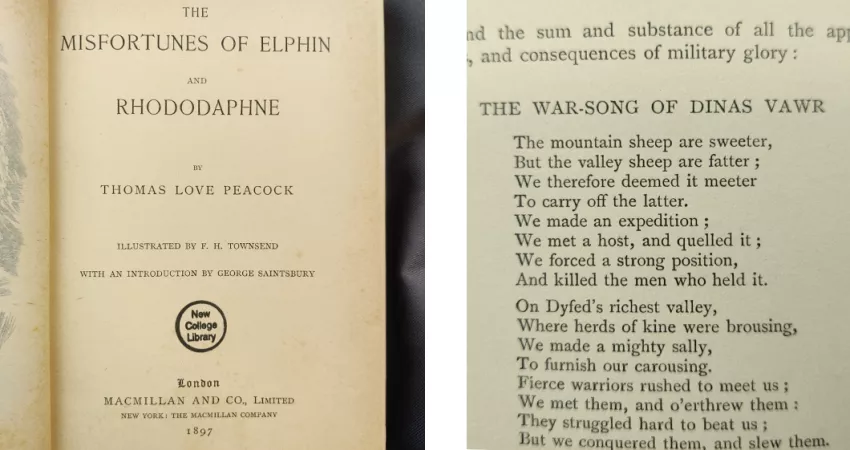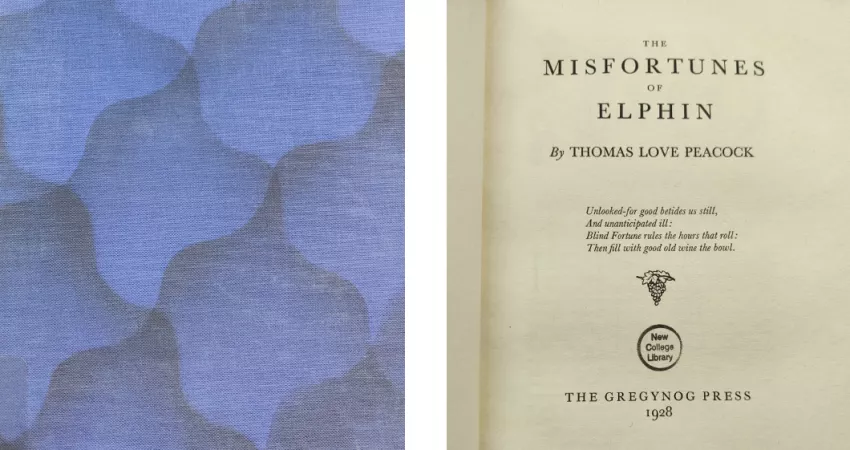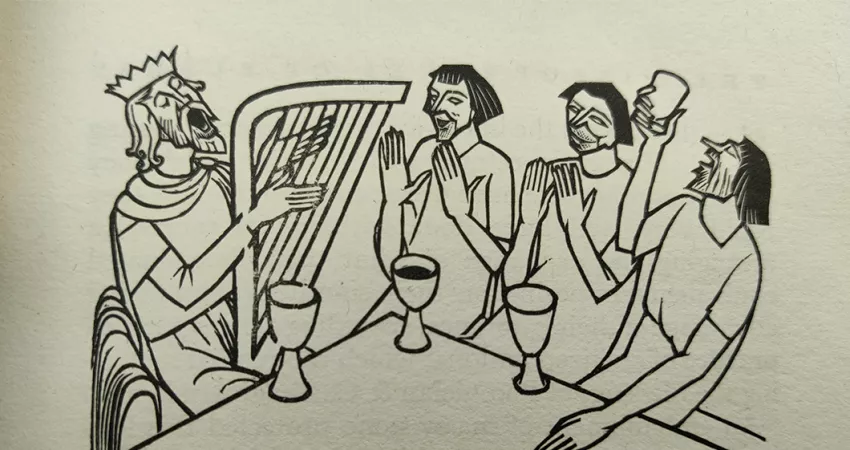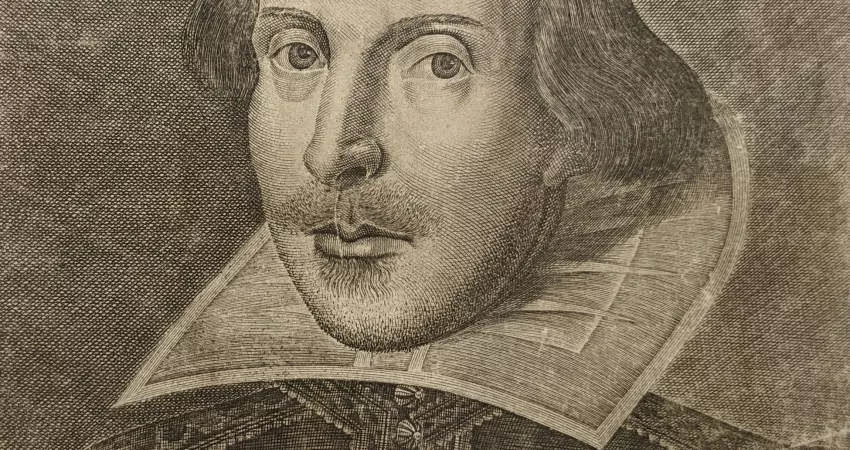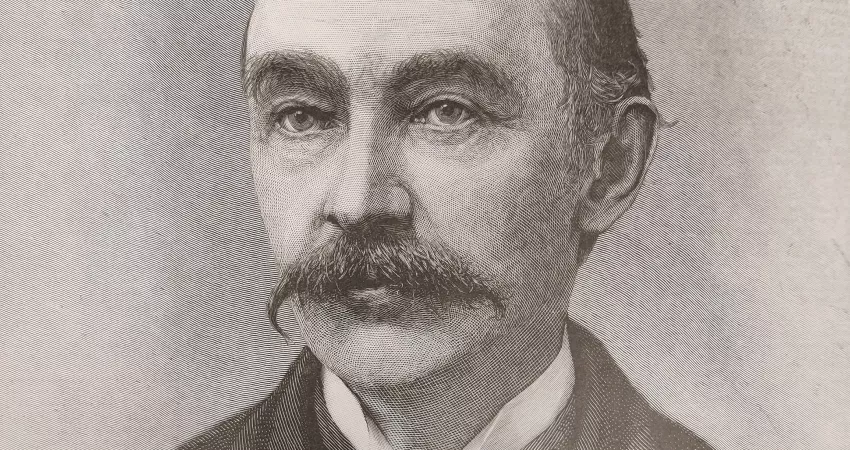In the eighteenth century, English literature entered its ‘Augustan age’.
This was an era of neoclassicism, when English writers emulated and were inspired by the classical writers of the Roman Emperor Augustus’s reign—Horace, Livy, Ovid, Prorpertius, and Virgil. A time of literary invention, it saw the development of the English novel in Daniel Defoe’s Robinson Crusoe (1719), the expansion of satire with Jonathan Swift’s Gulliver’s Travels (1726), and a focus on the ideals of order and control.
Although early eighteenth-century prose is not especially well represented in New College Library’s collections, the Library does contain several interesting works from this period. Below, you can see the first part of a sumptuous six-volume, illustrated translation of The Iliad of Homer, by Alexander Pope (1688–1744). A member of the ‘Scriblerus Club’ that included Jonathan Swift, John Gay, and Dr Arbuthnot, Pope was one of the central figures of the Augustan age.
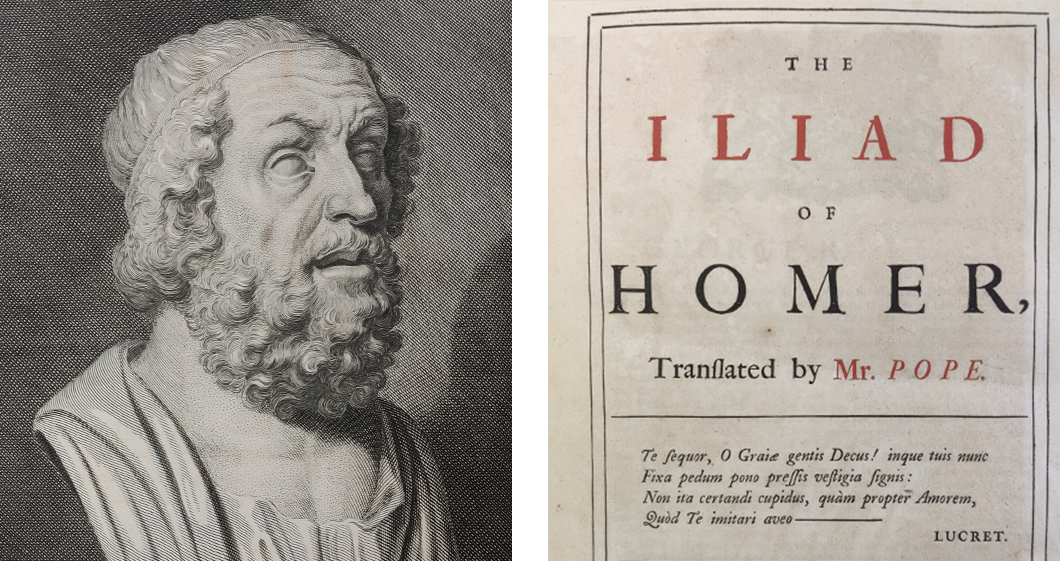
On the right: The title-page of the first volume of Pope’s translation of the Iliad
Both New College Library, Oxford, BT3.37.1
Pope’s Iliad was innovative. His was an approach to translation that took liberties with the original Greek text, to ensure something stylish in English verse and his chosen poetic form, the iambic pentameter couplet. It was published, too, in quarto format, when English editions of canonical poets invariably appeared in folio. Published by subscription and in instalments (the first volume in 1715, the last, 1720), its publisher, Bernard Lintot, required only the proceeds of the sales of the first volume to pay for the production of the second, and so on, till the sixth. The subscription list, headed by ‘Her Royal Highness the Princess’, is extraordinarily grand with 49 earls, 17 dukes, eight countesses, seven duchesses, three marquises, one marchioness—and ten Oxford college libraries. In the picture below, you can see that New College was one of these.
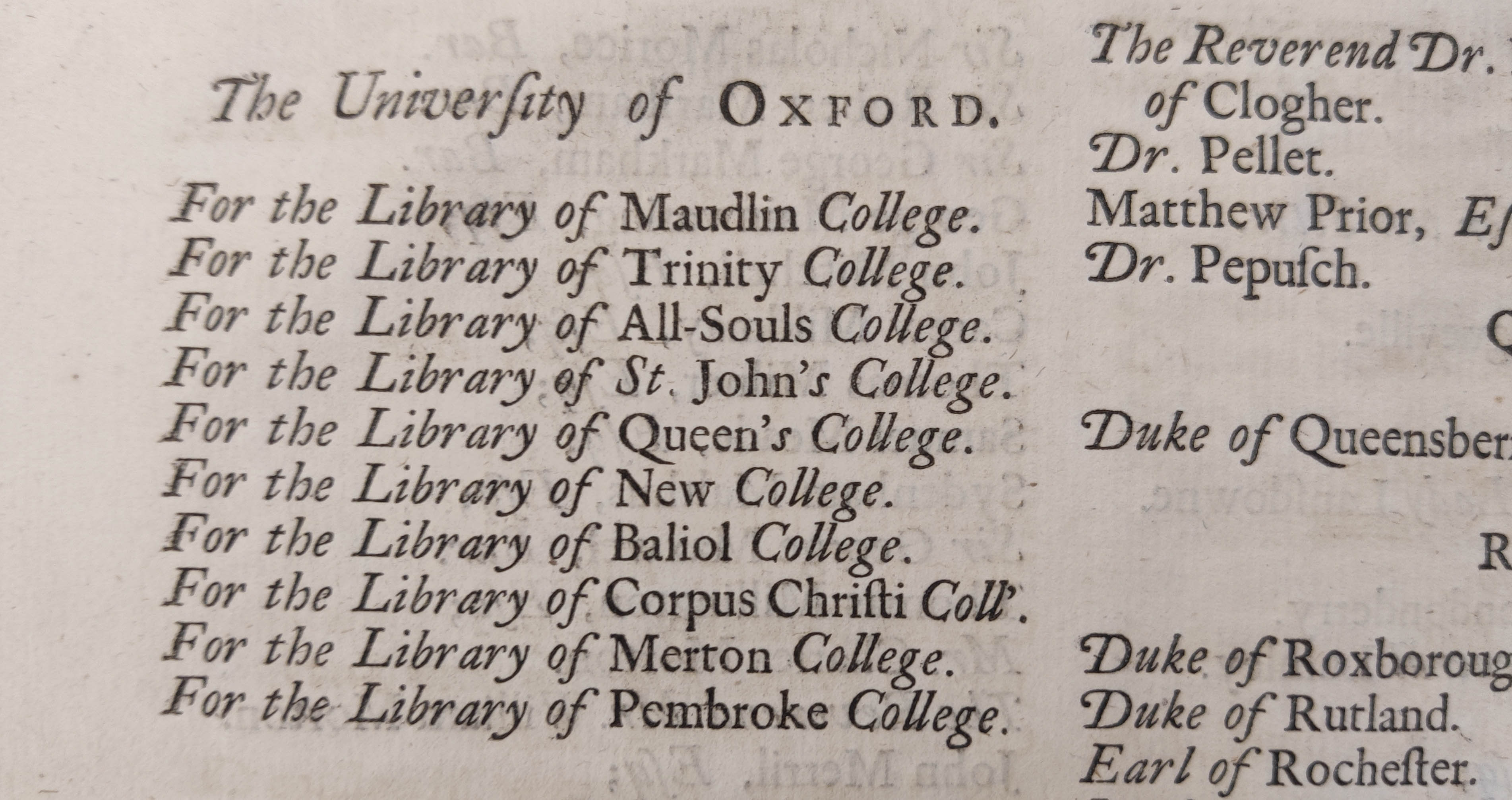
Pope’s literary output was by no means limited to purely translation. He also produced an edition of Shakespeare’s work, helped to establish the emerging industry of literary criticism, and experimented with epic poetry. This sheer diversity is represented in an early copy of Pope’s works in our collections, dating from 1717. To find out more about this volume, explore the gallery below or take a look at this New College Note.
As one of the leading literary figures of his day, Alexander Pope’s neoclassical influences soon spread. Indeed, this influence can be seen in New College’s own history, as it is reflected in poetry with a distinct New College connection. In recent years, the Library has developed its collection of books relating to the poet William Somervile (1675–1742), who studied at New College. You can discover more about his life and work in this New College Note from 2022.
A man passionate about both poetry and hunting, his most famous work is the epic poem The Chace—first published in 1735. This poem—essentially a history of hunting in England—builds on the classical theme of Augustan poetry, as in it Somervile pioneered an early English georgic. Considered to be the poet Virgil’s second major work, the Georgics also has a pastoral theme, focusing on agriculture. New College Library now holds several copies of Somervile’s Chace, including the first edition shown below. Click on the dots to discover more.
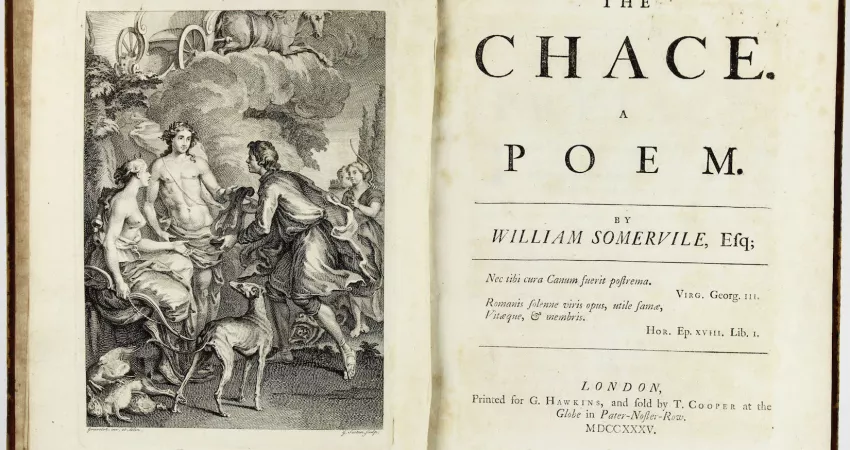
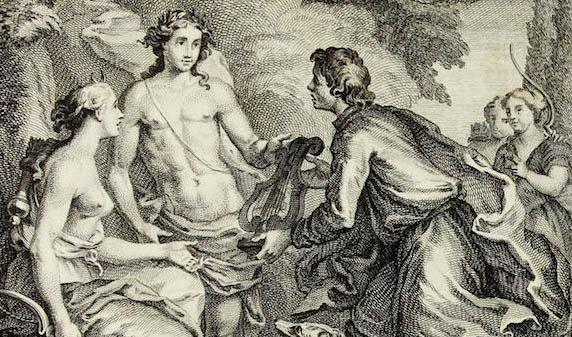
This edition includes a superb engraving, depicting the poet presenting his lyre to Diana, goddess of the hunt. It was created by Gérard Jean-Baptiste Scotin.

In keeping with the neo-classical influence on Augustan poetry, two classical quotations are included on the title-page. The first is taken from Virgil’s Georgics, and the second from Horace’s Epistles.
New College Library, Oxford, NB.66.33
Two other New College copies of The Chace in our collections also stand out. Both NB.66.37 (dating from 1811–12) and NB.73.5 (dating from 1804) include spectacular fore-edge paintings of hunting scenes.

A scene painted on the edges of book pages, fore-edge paintings can often only be seen when a book’s leaves are fanned. You can have a look at the painting in NB.73.5 above. The intricacy of both of these paintings is astounding, reflecting fashions in book production of this period and beyond, with the book industry, or indeed later illustrators, inventing ways to make products stand out and attract the interest of potential buyers, or simply to make their copies unique and special.
There was, though, a reaction to the austere, rational, and neoclassical literature of the Augustan age: Romanticism.
This new literary movement emerged at the end of the eighteenth century and covered a range of developments across literature and art, which all stressed the importance of expressing authentic feelings. A product of the French Revolution and a German reaction against French Neo-Classicism, its poetry aimed to give a voice to those ignored by society—such as the rural poor, children, and fallen women—as well as highlighting the importance of a natural world that had started to be threatened by the Industrial Revolution sweeping across the country.
Its poets, authors, and artists—such as Samuel Taylor Coleridge and William Wordsworth—had a profound influence on both contemporary literature and subsequent literary works. Indeed, it was Coleridge and Wordsworth’s publication of Lyrical Ballads, an anonymous collaborative work of poetry, in 1798 that effectively marked the birth of English Romanticism as a literary movement.
New College Library holds a range of texts from this important period of English Literature. Although Wordsworth had contributed the majority of the poems to Lyrical Ballads, by far the longest poem, and the greatest, was Coleridge’s ‘The Rime of the Ancient Marinere’, an extraordinarily powerful tale of crime, punishment, and redemption. Slightly reworked versions of Coleridge’s masterpiece were then published in subsequent versions of Lyrical Ballads.
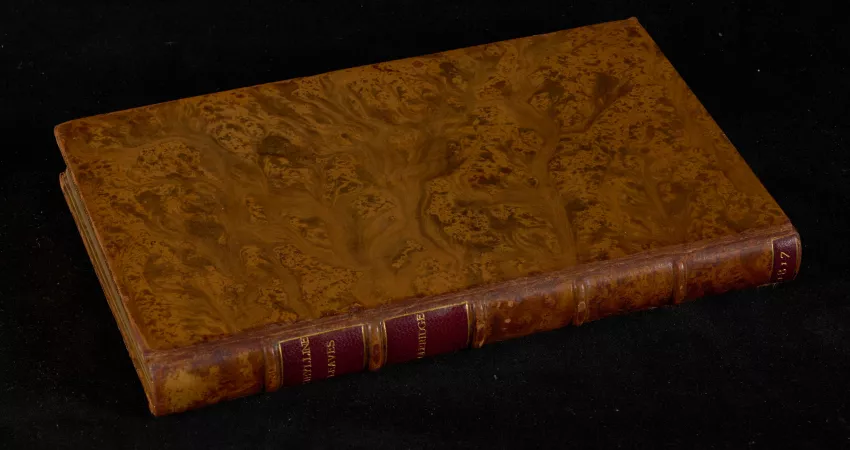

This binding is a fine example of a 'tree calf’ binding. Here, a mixture of pigment and acid is run across the covers. The resultant effect leaves the impression of a tree.
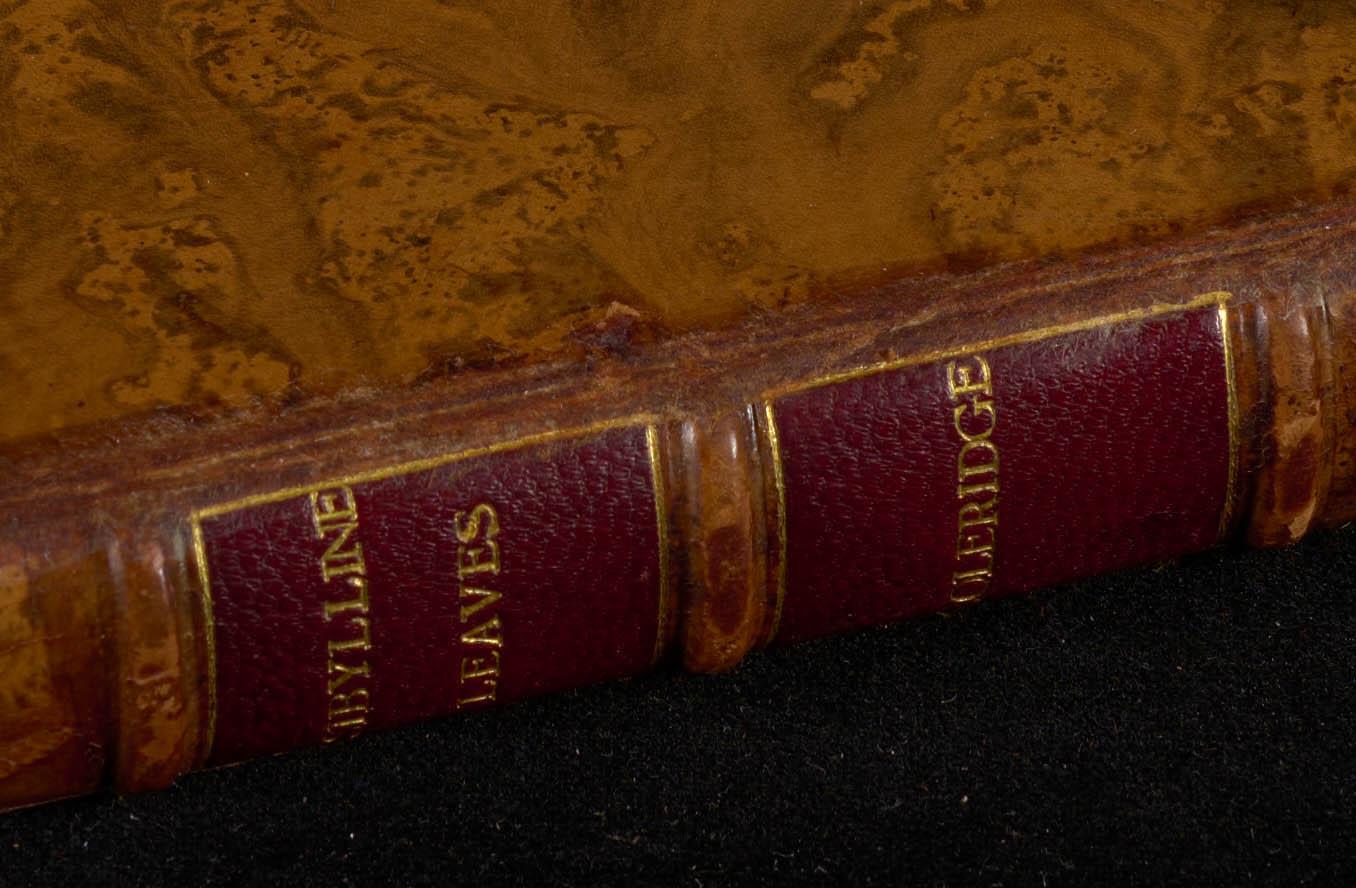
Note the gold tooling on the spine—a method of impressing lettering on a binding through a sheet of 22 or 23 carat gold leaf.

This book was bound by the famed bookbinders Sangorski & Sutcliffe of London. The binding was originally based in Bloomsbury (pictured above).
New College Library, Oxford, NB.73.40
Afterwards, the poem was published in 1817 in a new work, entitled Sibylline Leaves: A Collection of Poems. Above, you can see the superb New College Library copy of this book. Click on the dots to discover more about its beautiful binding.
Sibylline Leaves was a particularly influential work as it published ‘The Rime of the Ancient Mariner’ in a notably revised, expanded version (the most well-known one today)—with an extensive marginal gloss and modernisation of some of the poem's archaic language. The volume also included many of Coleridge’s other great poems: ‘Fears in Solitude’, ‘The Eolian Harp’, ‘This Lime Tree Bower My Prison’, and ‘Frost at Midnight’. It did, though, exclude Coleridge’s other two most celebrated poems—‘Kubla Khan’ and ‘Christabel’—which, along with the ‘Ancient Mariner’, have supernatural themes and a hypnotic quality, likely stemming in part from the poet's opium addiction. The proverbial phrase ‘an albatross around your neck’, meaning an inescapable burden, derives from Coleridge’s ballad.
Unsurprisingly, this work has been published in several different editions over the centuries. In the galleries below, you can see two sumptuously decorated editions in New College’s collections—dating from the late nineteenth and early twentieth centuries. The first dates from 1875 and includes illustrations by the French artist Gustave Doré (1832–1883), who created over 10,000 illustrations throughout his long career.
The second edition is slightly later, dating from 1910, and was illustrated by the Hungarian-born American, Willy Pogány (1882–1955), famed especially for his art nouveau children's book illustrations. Pogány’s The Rime of the Ancient Mariner, published by George G. Harrap in 1910, is widely accredited to be his master work of book design and illustration. New College’s copy is number 225 of 525 copies of the limited edition, signed by the illustrator. In total, the book contains twenty leaves of plates in blending watercolour, other fine monochrome illustrations, pages with exquisite flourishing borders, and gorgeous flowing calligraphic text. As you can see in the gallery below, these lavish otherworldly illustrations superbly capture the phantasmagorical elements of Coleridge’s magnificent poem, one of the most famous in the English language.
At the same time that Romanticism revolutionised poetry, the popularity of the novel greatly increased.
Indeed, at this time the novel greatly developed as a literary form, entering a new period that was, in part, influenced by the wider Romantic movement. As discussed above, the English novel had its origins earlier in the eighteenth century, but it was in the late eighteenth and early nineteenth centuries that world-famous authors like Jane Austen, Walter Scott, and Mary Shelley first began to write and experiment with the novel as a literary format.
The novel’s increasing popularity throughout this period was due to a range of factors. To begin with, literacy rates had steadily increased throughout—they had more than doubled over the course of the eighteenth century. This fact, combined with greater leisure time and a nascent publishing industry, helped to create a steady market for fiction, with greater numbers of both men and women starting to read and write for the first time.
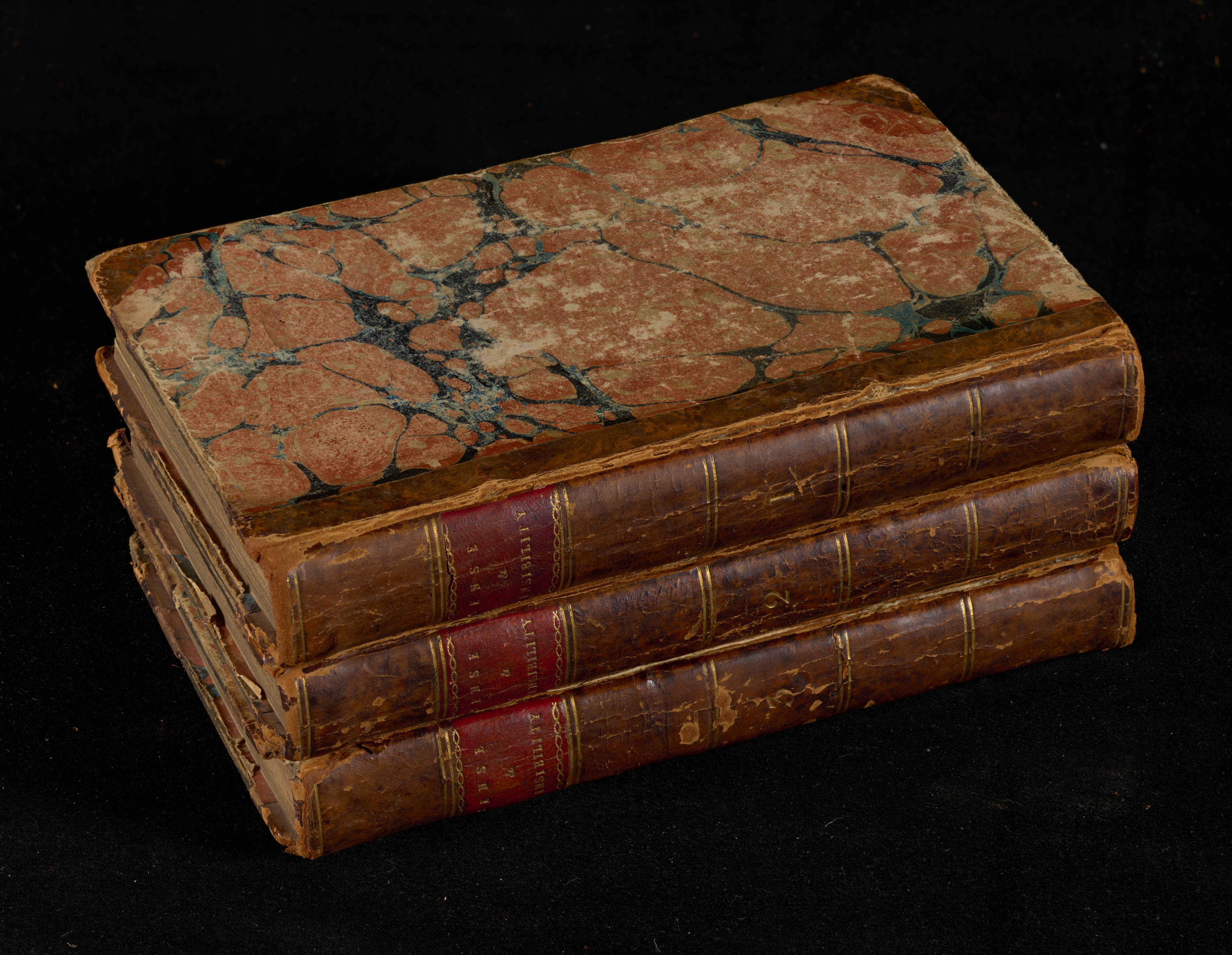
Key prose authors from this period are well represented in the collection at New College Library. Above, you can see the binding of the New College first edition of Sense and Sensibility, the first of the six published novels written by Jane Austen (1775–1817), which appeared in 1811. As you can see in the image below, this work was printed ‘For the Author’, that is, on a commission basis, with Austen retaining her copyright. The novel was an immediate success—this first print run of possibly 750 or 1,000 copies sold out within two years.
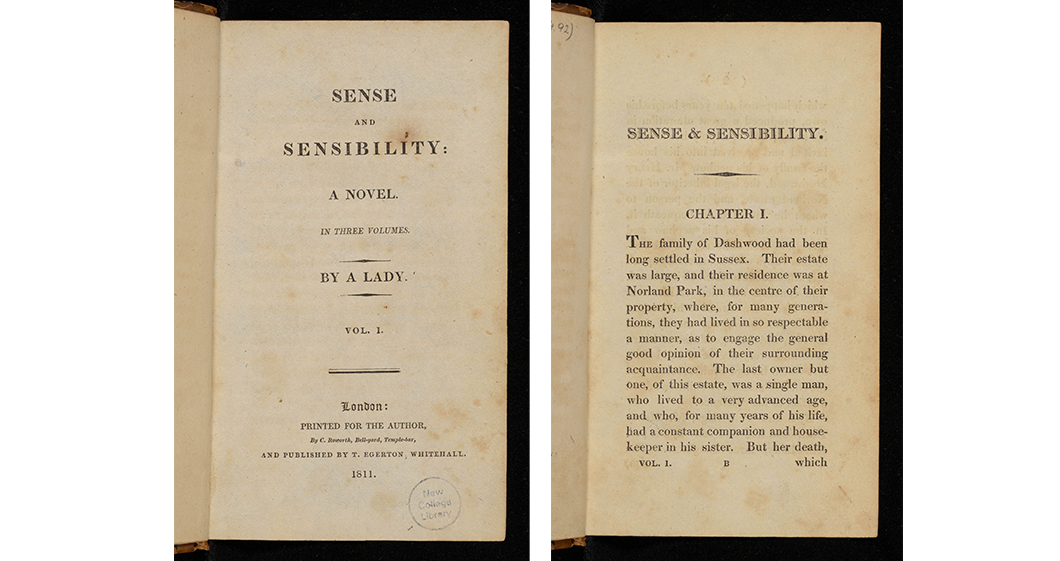
Although contemporary women novelists such as Ann Radcliffe or Maria Edgeworth did not hesitate to attach their names to their creations in print, it is interesting that Austen’s book appeared anonymously—written ‘By a Lady’. This fact may be explained by the fact that she was a clergyman’s daughter, publishing fiction at a time when certain members of the literary elite were concerned about the rising popularity of the novel—particularly amongst women. Samuel Johnson (1709–1784) had described the novel’s readers as ‘the young, the ignorant, and the idle’, whilst Henry James Pye—Poet Laureate from 1790 until 1813—was concerned ‘about the general effect of novel-reading on the gentler sex’.
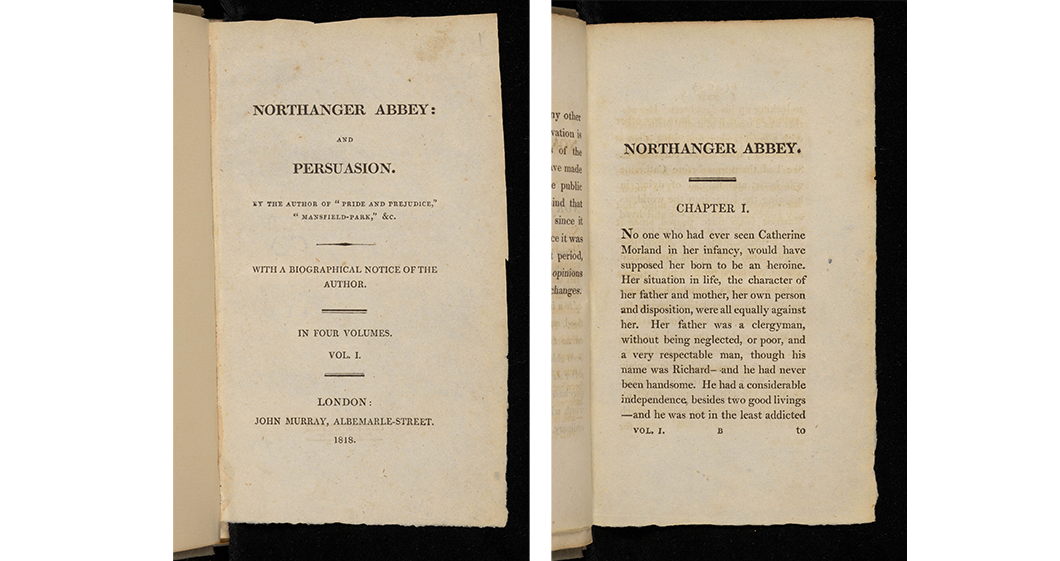
New College Library is also fortunate to own a first edition copy of Austen’s last published work—a four-volume edition of Northanger Abbey: and Persuasion—which appeared after Austen’s death in 1818. Printed in 1,750 copies on very inexpensive paper, it earned her surviving family over £500, more than any of her earlier novels had done. With a ’biographical notice of the author’ at the beginning of volume one, by her sister Cassandra, this work officially ceased Jane Austen’s literary anonymity.
Both of these novels arrived at the Library thanks to the generosity of John Hanbury Angus Sparrow (1906–1992), whose bookplate can be found on the inside boards of both volumes. A scholar of both Winchester College and New College, and later Warden of All Souls College and honorary fellow of New College, Sparrow was a knowledgeable bibliophile and life-long collector of books.
In this period, the novels of Austen’s contemporary Walter Scott (1771–1832) also proved popular, with Scott developing a new form of novel writing—the historical novel. This new form was set in a particular period of history, and it attempted to bring the past to life with its depiction of realistic characters. Novels about the past, such as Jane Porter’s The Scottish Chiefs, had been published before, but it was Walter Scott who was by far the most important and influential figure in popularising this type of novel.
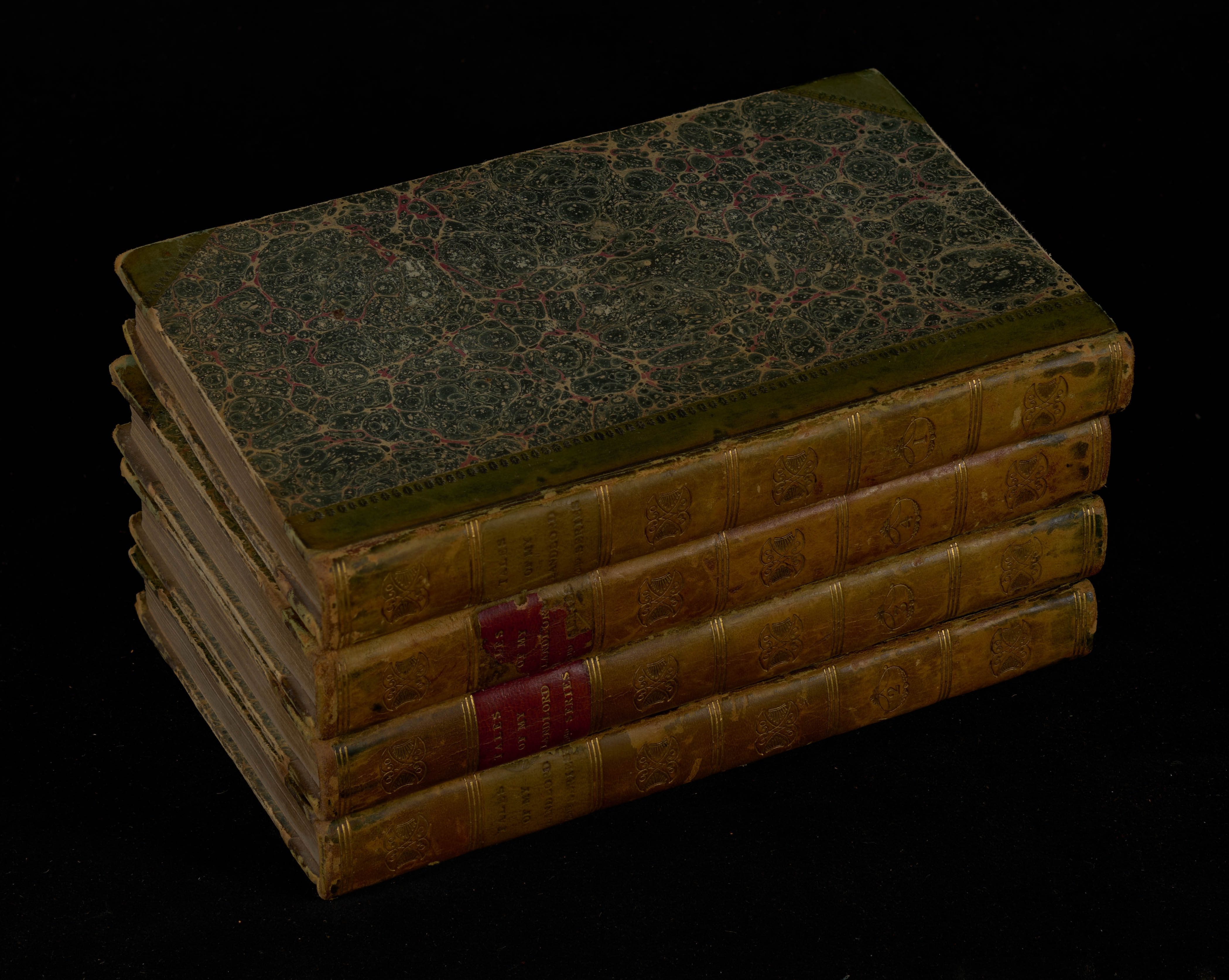
Above, you can see the binding of an early work by Walter Scott held in New College Library’s collections. Dating from 1819, it is the third series of Scott’s Tales of my Landlord, which includes the novels The Bride of Lammermoor and A Legend of Montrose. Although he is not as widely read today, it is important not to underestimate Scott’s craftsmanship and popularity. He was easily the most successful writer of his day, with his books selling well throughout the nineteenth century.
A poet as well as a novelist, Scott was greatly influenced by Romanticism—particularly the German Romanticism that was popular in Edinburgh at the time (he even wrote that he was ‘German-mad’ in a letter dated 13th December, 1827). As such, there are clear parallels in his prose work and the Romantic poets. Similarly to Wordsworth and Coleridge, he portrayed a wide range of characters—from all social classes—giving them an individual voice in the use of a variety of geographic and social dialects. A perfect example of this style of poetry can be found in the collections at New College Library. Below, you can see the binding and title-page of the College’s first edition of Rokeby, a narrative poem in six cantos that was first published in 1813. Set in Teesdale during the English Civil War, this historical poem is a tale of love, revenge, and long-lost sons—one that focuses not only on the aristocracy, but also on the way that historical events impact the lives of ordinary people.
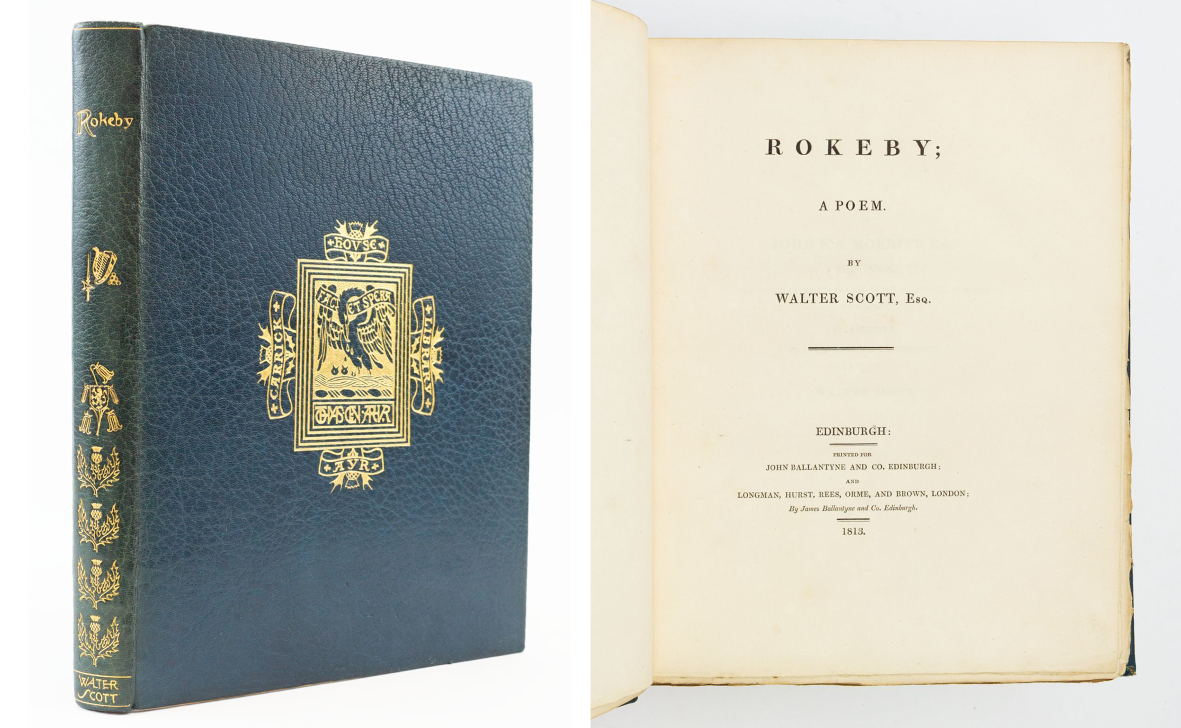
Note the beautiful binding visible in the image above. It was made by James MacLehose (1811–85)—a bookseller and bookbinder active in Glasgow. The MacLehose workshop produced high quality bindings, and catered in particular to private book collectors. This particular binding was commissioned by Thomas Glen Arthur (1858–1907), who was a successful clothing merchant and textile manufacturer in Glasgow. This New College edition, therefore, is a fitting tribute to one of Scotland’s most famous authors, as the book itself is a thoroughly Scottish item.
Thanks to his popularity, Walter Scott had a profound influence on English literature produced in this period. Scott’s contemporary, Thomas Love Peacock (1785–1866), demonstrates this perfectly, even going on a solitary walking tour of Scotland in the autumn of 1806 to visit many of the romantic scenes that had been popularized by Scott in his writing. A truly remarkable and idiosyncratic writer, Thomas Love Peacock wrote in a range of styles, influenced not only by Romanticism, but also by classical authors and medieval folklore.
Scott epitomized his native Scotland in his writing, and Thomas Love Peacock did something of the same kind for Wales. Although born in England, a particular theme running through his work is an appreciation of Welsh culture, the Welsh landscape, and the Welsh language. In 1810, Peacock had stayed in North Wales for fifteen months, taking lodgings at Tan-y-Bwlch in Merionith. Describing the region as ‘a terrestrial paradise’, he developed a lasting interest in Welsh traditions—an interest which only grew after 1820, when he married a Welsh parson’s daughter, Jane Gryffydh.
This interest in Wales was then solidified in 1829, when he published his The Misfortunes of Elphin, a novel heavily based on the legends of sixth century Wales. Recounting the adventures of the bard Taliesin, the princes Elphin ap Gwythno and Seithenyn ap Seithyn, and King Arthur, the Misfortunes of Elphin is based on Peacock’s research of early Welsh materials, many of them untranslated into English at the time. He included many loose translations from bardic poetry, but also included original poems inspired by the Welsh language. One of the most well-known from the collection is entitled ‘The War-Song of Dinas’, with the memorable opening lines:
But the valley sheep are fatter;
We therefore deemed it meeter
To carry off the latter.
In the gallery above, you can see images from three important editions of this text held at New College Library. First, you can see the binding and title-page of the first edition, published in 1829. Secondly, New College owns a superbly bound early edition from 1897. This edition features beautiful endpapers depicting, appropriately, a peacock. As it includes illustrations by F. H. Townsend too—who also illustrated the works of Charlotte Brontë, Nathaniel Hawthorne, and Rudyard Kipling—this book is, in itself, a work of art. Finally, the College has recently acquired a later fine-press edition of the text, dating from 1928 and published by the Gregynog Press. Founded in 1922 by the sisters and art patrons Margaret and Gwendoline Davies, this Welsh private press became one of the most important in the entire country in the pre-war era. If you look at the quality of the printing and the illustrations included in this edition, it is easy to see why this press was so successful, bringing Peacock’s work to life.
The ‘long eighteenth century’ saw many developments in English literature.
It was this period that saw the development of two important strands in literary history, the ongoing rise of the English novel, and increasingly complex forms of book production. As we have seen on this page, the collections at New College Library reflect key changes in literature throughout this decade. The works of some authors in our collections—such as Jane Austen and Samuel Taylor Coleridge—are very well-known and have been studied in great depth. Other authors—such as William Somervile and Thomas Love Peacock—warrant much further investigation, with their works revealing both the spread of literary movements across the country and the unique literary history of New College as an institution.
The next tab of this exhibition takes us to much more recent history. On the following page, we showcase the Victorian period in New College’s extensive collections—a period of increasing industrialisation, which greatly affected both the content and manufacture of books. Click below to discover more.

